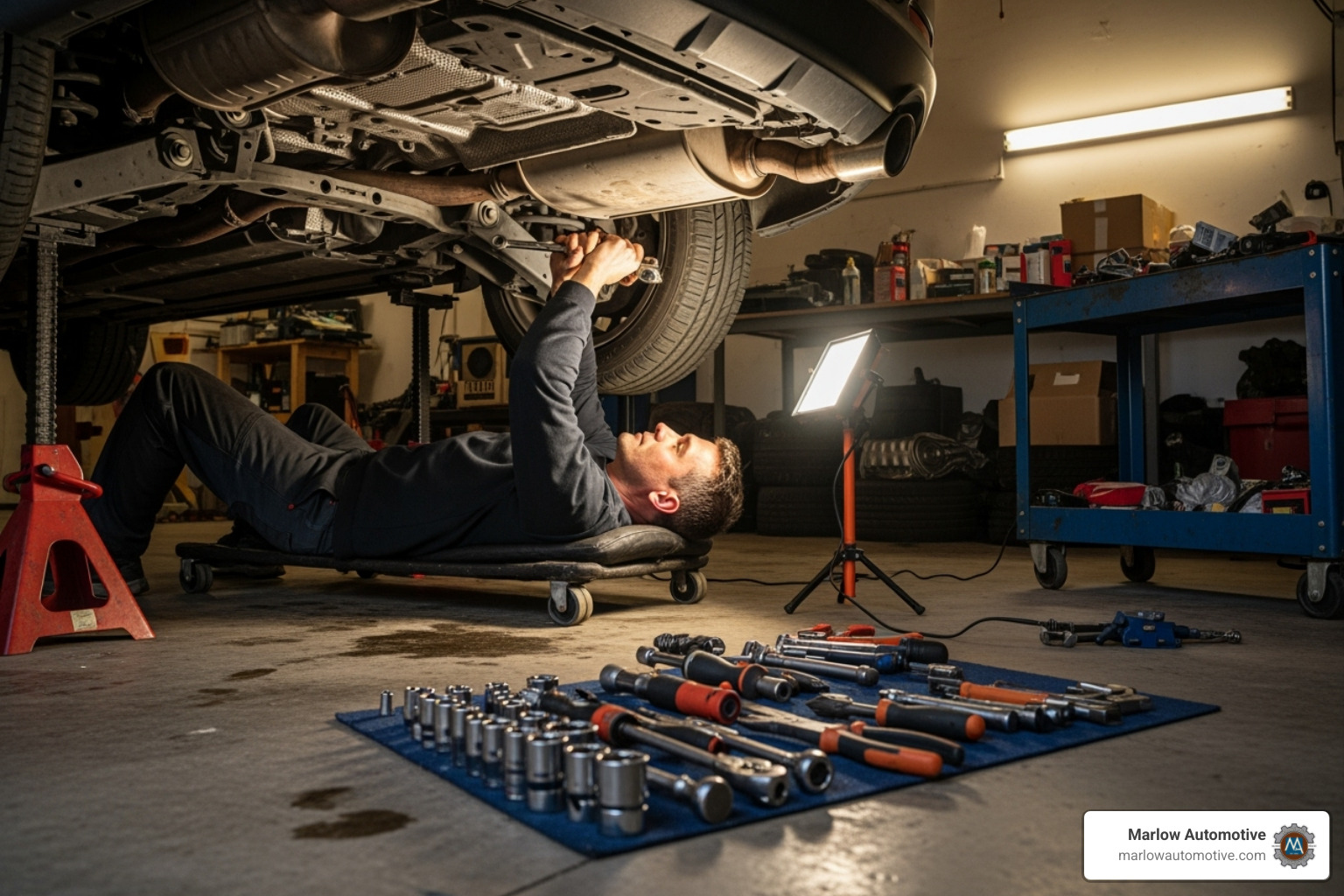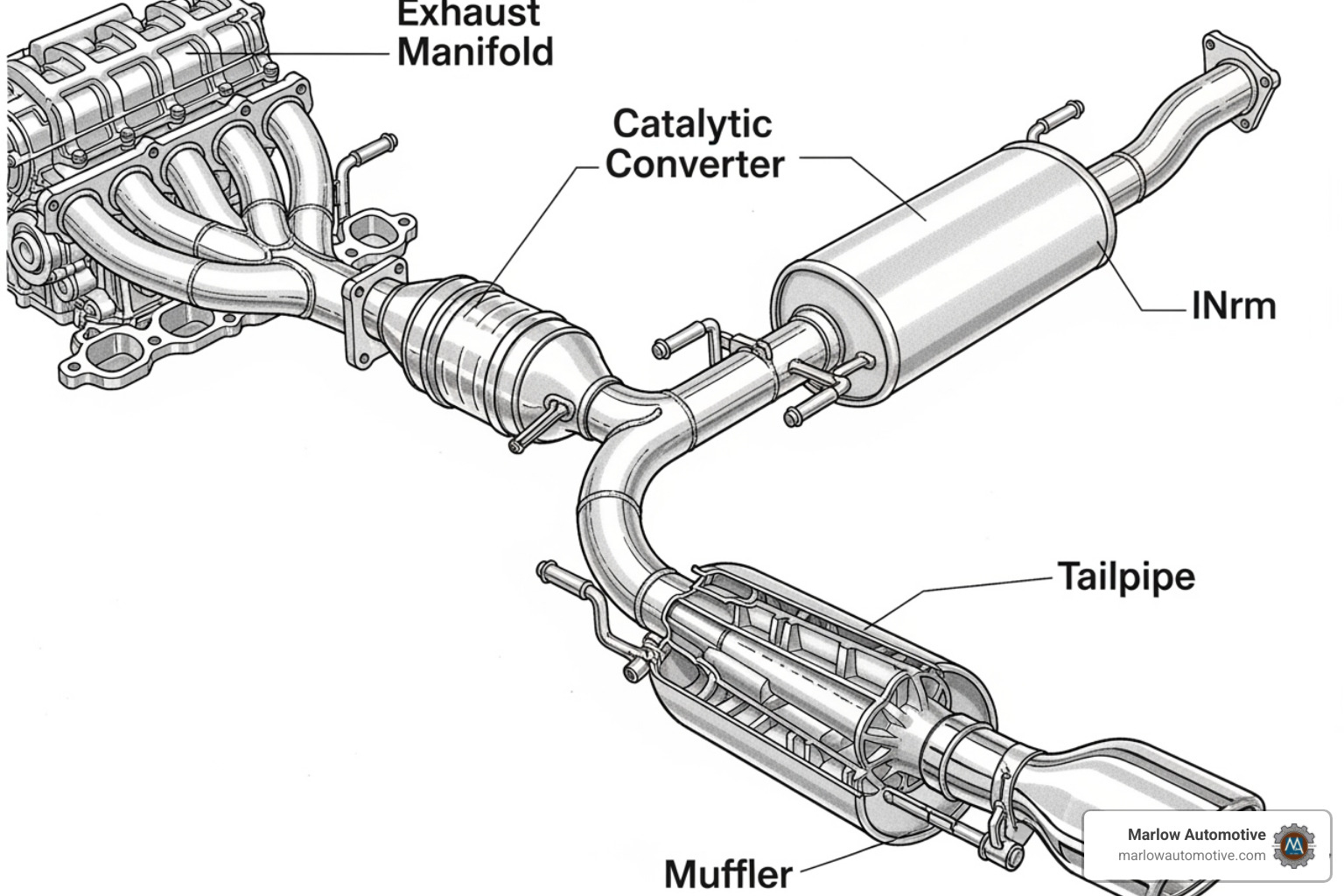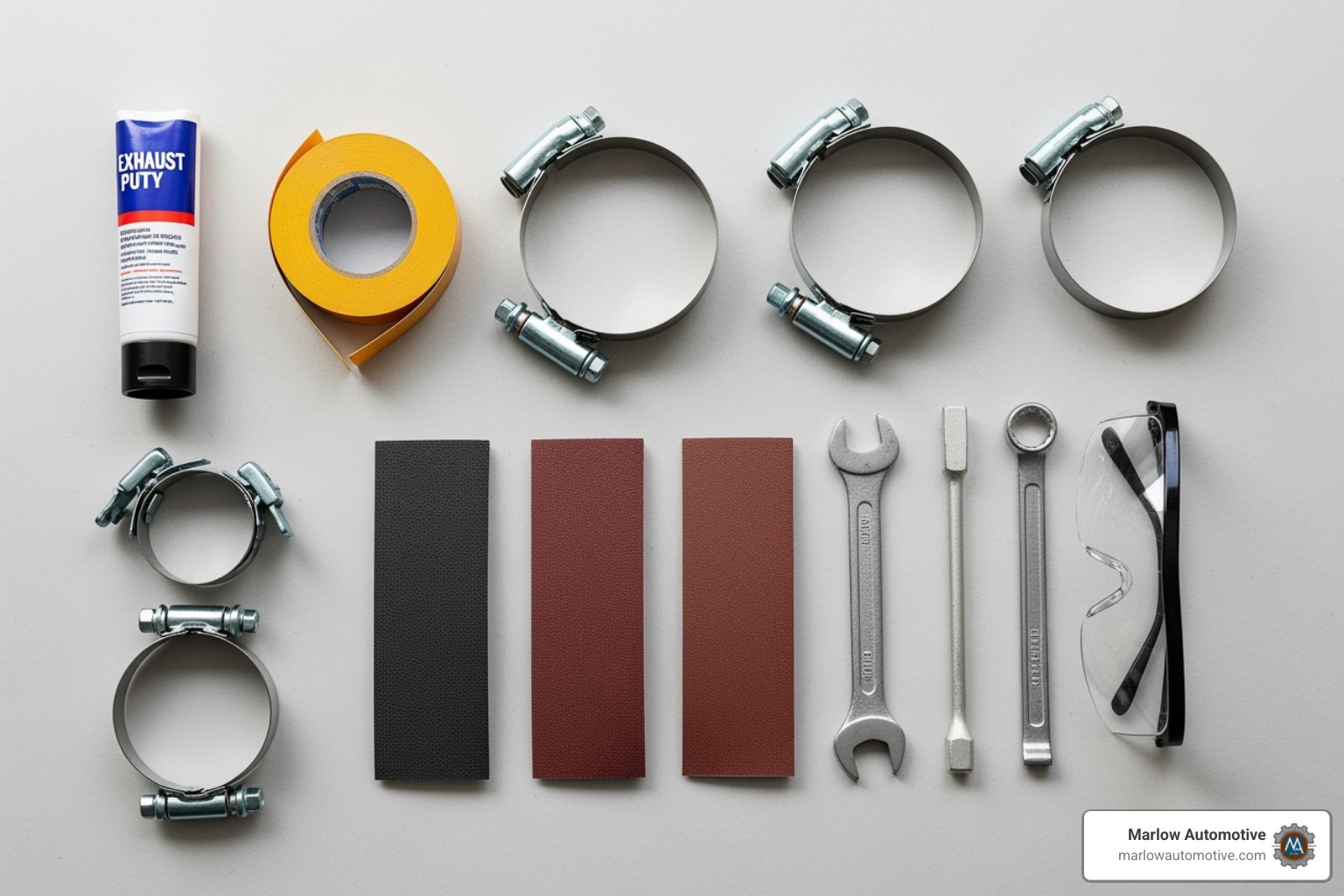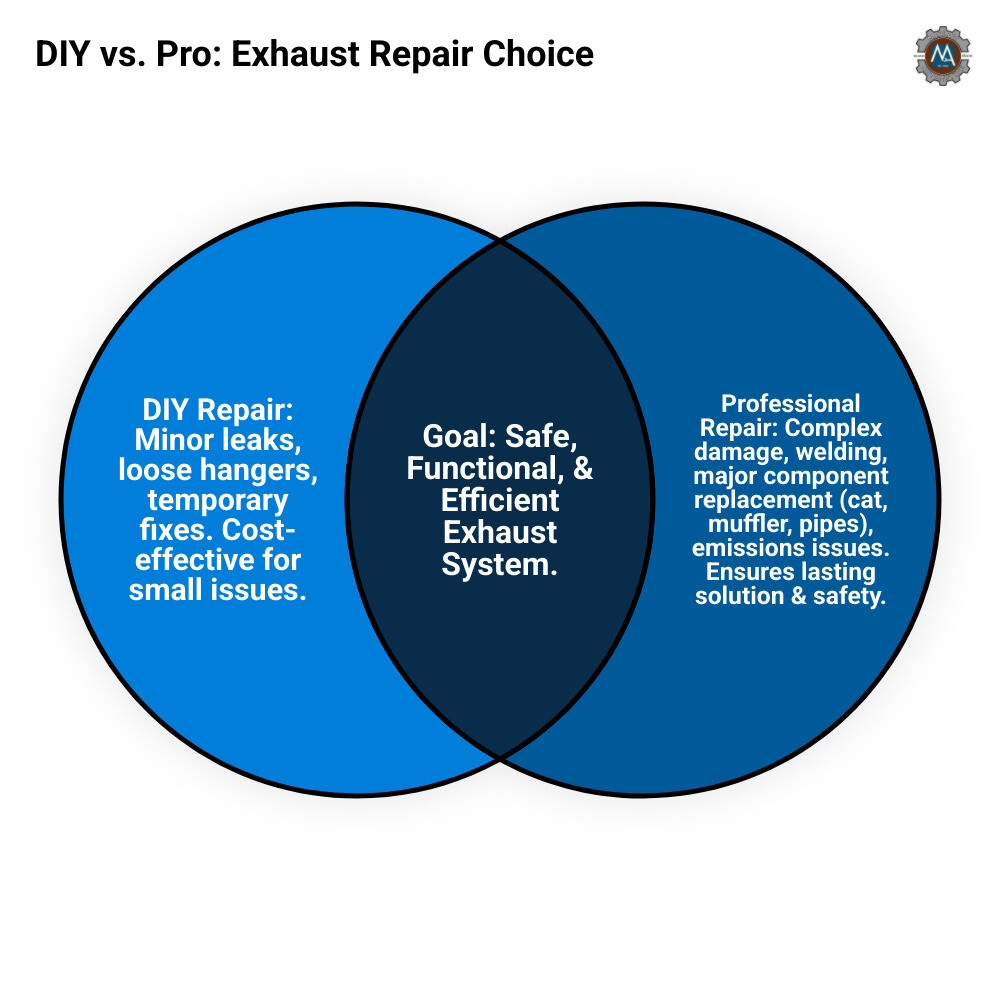Your Weekend Project: Tackle Automotive Exhaust Repair at Home

From Roaring Dragon to Purring Kitten
Car exhaust repair doesn't always mean an expensive trip to the dealership. Many common exhaust issues can be fixed at home with basic tools and a free afternoon.
Quick DIY Exhaust Repair Solutions:
- Small holes or cracks - Use exhaust putty or repair paste ($5-10)
- Minor leaks - Apply exhaust tape or bandages ($10-15)
- Loose connections - Secure with exhaust clamps ($15-20)
- Total DIY cost - Under $50 vs $75-400+ professional repair
As one DIY enthusiast shared: "A loud muffler and a dragging tailpipe may be classic comedy gold, but a damaged exhaust system is no joke."
Your car's exhaust system does more than muffle noise; it removes deadly carbon monoxide from the engine and keeps fumes away from passengers. A failing system leads to loud noises, exhaust smells, and poor fuel economy.
Safety comes first with any exhaust repair. Never work under a car supported only by a jack—always use axle stands or ramps. While small leaks can be patched at home, major damage needs professional attention.
The good news is that many exhaust problems start small. Catching them early for a simple DIY fix can save you hundreds and keep your car running smoothly.

Is Your Exhaust Crying for Help? Recognizing the Telltale Signs
Your car will give you obvious signs when its exhaust system is struggling. This system channels dangerous gases away from the cabin, reduces engine noise, and maintains efficiency.
A failing exhaust system impacts your car in three ways. Performance suffers as the engine loses proper back pressure, making it feel sluggish. Fuel bills increase as the engine works harder. And emissions rise, which can cause you to fail an emissions test.
Look for these telltale signs:
- Loud Noises: A sudden rumbling or popping sound, like a race car, indicates a leak. Hissing often points to a manifold crack, while popping suggests a loose connection.
- Rattling or Clunking: These noises, especially on startup or over bumps, usually mean a broken hanger or loose heat shield.
- Check Engine Light: Oxygen sensors monitor exhaust gases. If they or the catalytic converter malfunction, your car's computer triggers the light. We can diagnose the issue with our check engine light services.
- Rotten Egg Smell: A sulfur smell from your exhaust is a classic sign of a failing catalytic converter.
- Visible Damage: Look under your car for rust, cracks, or holes. In areas with road salt, this damage can appear in just 2-5 years.
- Dangling Pipe: A broken hanger can cause a pipe to drag, which is noisy and dangerous.
- Fumes in the Cabin or Drowsiness: This is a medical emergency indicating possible carbon monoxide poisoning. Pull over, get fresh air immediately, and do not drive the car. A leak can allow this deadly, odorless gas into your cabin. Never ignore this sign.
Anatomy of Your Car's Exhaust System
Understanding your exhaust system makes car exhaust repair less mysterious. It's a series of components that guide gases away from the engine, clean them, and reduce noise.

- Exhaust Manifold: Bolts to the engine, collecting gases from the cylinders into one pipe. A crack can cause a ticking sound when the engine is cold.
- Oxygen Sensors: Located before and after the catalytic converter, they monitor oxygen levels to optimize engine performance and emissions.
- Catalytic Converter: Required on cars since 1975, it uses precious metals to convert harmful gases like carbon monoxide into safer substances. Learn more about the evolution of catalytic converters.
- Resonator: Works with the muffler to fine-tune the exhaust sound by canceling out certain frequencies.
- Exhaust Pipes: Connect all components and are vulnerable to damage from heat, vibration, and weather.
- Muffler: Contains chambers and baffles to break up sound waves and quiet the engine.
- Tailpipe: The exit point for all exhaust gases.
- Hangers and Gaskets: Secure and seal the entire system.
Most mufflers last 40,000-80,000 miles, but road salt can significantly shorten this lifespan.
Common Causes of Exhaust Damage
Your exhaust system endures extreme heat, vibration, and weather. Common causes of damage include:
- Rust and Corrosion: This is the biggest enemy, especially from road salt. Moisture, chemicals, and salt corrode metal parts.
- Road Debris: Hitting potholes or debris can dent, crack, or break exhaust components.
- Worn-out Hangers: The rubber or metal brackets that hold the system can degrade and break over time.
- Age and Mileage: Gaskets dry out, welds weaken, and components like the catalytic converter (which lasts about 10 years or 100,000 miles) eventually fail.
- Extreme Weather: Constant temperature changes cause metal to expand and contract, leading to stress cracks.
- Short Trips: These prevent the exhaust from getting hot enough to burn off internal condensation. The trapped moisture becomes acidic and causes rust from the inside out.
A Step-by-Step Guide to Basic Car Exhaust Repair
Tackling minor car exhaust repair at home can be a rewarding, money-saving project. However, safety is the top priority.
Safety First:
- Use Axle Stands: Never work under a car supported only by a jack. Always use sturdy axle stands or ramps and chock the wheels.
- Wear Eye Protection: Safety glasses protect your eyes from rust, dirt, and chemicals.
- Work on a Cold Engine: The exhaust system gets extremely hot. Let it cool completely to prevent severe burns.
Finding the Leak:
- Visual Inspection: Look for obvious holes, cracks, or loose connections, especially at welds and flanges.
- Soapy Water Method: With the engine cold, use a shop vacuum or leaf blower to pressurize the system through the tailpipe (seal the connection with tape). Spray soapy water on suspected areas and look for bubbles, which pinpoint the leak.
DIY fixes are effective temporary solutions for minor leaks and small holes until a professional repair is possible.
Essential Tools and Materials for Car Exhaust Repair
Having the right gear makes all the difference for a successful DIY car exhaust repair.

Here's what we'll likely need:
- Safety Gear:
- Axle stands or ramps
- Eye protection (safety glasses)
- Work gloves
- Cleaning & Preparation:
- Wire brush or sandpaper (around 100 grit works well for rust)
- Isopropyl alcohol or brake cleaner (for degreasing)
- Clean rags
- Repair Materials:
- Exhaust repair putty or exhaust repair paste: These are high-temperature sealants that harden like steel.
- Exhaust repair tape/bandage: A fiberglass-reinforced wrap that hardens to seal leaks.
- Exhaust clamps: These come in various styles (band clamps, U-bolt clamps) and are used to secure connections or to help seal patches. Jubilee clips (hose clamps) can also be used for smaller diameter pipes or to secure a patch.
- Optional but Helpful:
- Jack (for lifting, but always use stands for support)
- Shop vacuum or electric leaf blower (for leak detection)
- Soapy water in a spray bottle
- Heat gun or hairdryer (to speed up curing of some repair products)
- Basic hand tools (wrenches, screwdrivers, pliers)
Patching a Minor Leak: The DIY Process
Once you've found a minor leak (a small hole or crack), here's how to patch it.
- Clean the Area: This is a crucial step. Use a wire brush or 100-grit sandpaper to remove all rust and debris around the leak until you have bare metal. Wipe the area with isopropyl alcohol and let it dry.
- Apply Repair Material:
- For Putty/Paste: Following product instructions, press the putty firmly into and around the hole. Smooth it out for an even layer.
- For Tape/Bandage: Wrap the tape tightly around the damaged pipe, overlapping generously as directed by the product.
- For a larger hole: A "tin can trick" can provide a temporary bridge. Cut a can to fit inside the pipe, slide it in to connect the broken sections, secure it with jubilee clips, and cover the joint with exhaust paste.
- Secure with a Clamp (Optional): For added security, an exhaust clamp can hold the patch firmly while it cures.
- Cure the Patch: Curing can take 2-24 hours. Some products require heat curing by running the engine briefly, while others must dry completely first. A heat gun can speed up the process. Always follow the product's instructions.
- Check Your Work: After curing, the patch should be hard. Start the engine and listen for leaks. If the leak persists, you may need to reapply the patch or seek a professional repair.
DIY vs. Professional: When to Call in the Experts
Knowing when to DIY and when to call a professional for car exhaust repair is crucial for your safety and your car's health.
Good DIY Projects:
- Patching small holes or hairline cracks.
- Securing loose hangers.These temporary fixes can buy you time or help you pass an inspection.
Call the Professionals For:
- Major Repairs: Work on the catalytic converter, exhaust manifold, or large sections of pipe requires specialized tools and expertise. These are precision parts, and a mistake can be costly.
- Welding: For a durable, long-lasting solution, a proper weld is often necessary.
- Serious Safety Risks: If you smell exhaust in the cabin, feel drowsy while driving, or have a dangling pipe, seek immediate professional help due to carbon monoxide risks.
- Failed Emissions Tests: This often points to issues with the catalytic converter or oxygen sensors that require professional diagnosis. At Marlow Automotive, our technicians can handle any car exhaust repair to ensure your vehicle is safe and compliant.
Understanding the Costs of Professional Car Exhaust Repair
Cost is a major factor in deciding between DIY and professional car exhaust repair. Here's a general breakdown:

- Small Leak Patch: $5-$20 (DIY) vs. $75-$110 (Professional)
- Muffler Replacement: $215-$700 (Professional only)
- Exhaust Pipe Replacement: $800-$850 (Professional only)
- Exhaust Manifold Gasket: $250-$350+ (Professional, labor-intensive)
- Catalytic Converter Replacement: $1,500+ (Part only). The high cost of these parts has led to a rise in catalytic converter theft.
If your check engine light is on, our auto diagnostics in Plano, TX can pinpoint the problem, saving you from unnecessary repairs.
How to Prolong the Life of Your Exhaust System
A few simple habits can add years to your exhaust system's life and prevent costly car exhaust repair.
- Wash Your Undercarriage: Regularly wash off road salt, especially in winter. This corrosive mix can cause serious rust damage in just 2-5 years.
- Avoid Too Many Short Trips: Short trips don't let the exhaust get hot enough to evaporate condensation. This trapped moisture creates acids that cause rust from the inside out.
- Fix Minor Issues Promptly: A loose hanger or small hole can lead to bigger problems. A quick DIY patch can prevent more expensive damage later.
- Use Corrosion-Resistant Parts: When replacing parts, consider stainless steel. It costs more upfront but lasts much longer than standard steel.
- Perform Regular Inspections: Periodically check under your car for rust, cracks, or loose parts. Catching problems early saves you from emergency repairs. Our auto maintenance services can help keep your entire car in top shape.
Frequently Asked Questions about Exhaust Repair
When it comes to car exhaust repair, we get a lot of questions from concerned drivers. Let's tackle the most common ones with straight answers that'll help you make smart decisions about your vehicle.
Is it safe to drive with an exhaust leak?
It's not recommended and can be dangerous. The biggest risk is carbon monoxide poisoning. This deadly, odorless gas can seep into your cabin, causing dizziness, nausea, or worse. If you feel drowsy while driving, a leak could be the cause.
An exhaust leak also harms performance. It disrupts engine back pressure and confuses oxygen sensors, leading to poor fuel efficiency and acceleration. A small leak can worsen, causing more damage or parts to fall off. Furthermore, a loud, leaky exhaust can violate local noise ordinances and cause you to fail an emissions test. Any exhaust issue should be repaired as soon as possible.
How long does a DIY exhaust patch last?
DIY patches are temporary solutions. Their lifespan varies from weeks to nearly a year.
Durability depends on the quality of your preparation, the size of the leak, and environmental conditions like road salt and vibration. A well-prepped patch on a small hole can last for months, but a patch on a large, rusted area will likely fail quickly.
Think of a patch as a band-aid to help you pass an inspection or delay a costly repair. It is not a permanent fix. When the noise returns, it's time for a professional solution.
Can a bad exhaust cause my check engine light to come on?
Absolutely. A faulty exhaust is a common reason for the check engine light to come on.
- Oxygen Sensors: A leak or blockage can cause these sensors to send incorrect data to your car's computer, triggering the light.
- Catalytic Converter: If the converter is clogged or failing, sensors will detect the inefficiency and activate the light.
- Back Pressure: Severe blockages can create back pressure issues that indirectly cause the light to come on.
A check engine light, especially with other exhaust symptoms, signals the need for a diagnostic check. Ignoring it can lead to bigger problems. Our check engine light services can pinpoint the exact cause.
Conclusion: Know When to DIY and When to Call the Pros
We've covered how to spot exhaust problems and perform basic car exhaust repair. Fixing a small leak yourself is satisfying and saves money, but the key to DIY success is knowing your limits.
A DIY patch is great for a small hole, but major issues like a failing catalytic converter, welding needs, or serious safety risks require a professional. Recognizing these limitations isn't defeat—it's being smart. A sound exhaust system is critical for protecting you from fumes, maintaining engine efficiency, and controlling pollution.
That's where Marlow Automotive comes in. Our expert technicians handle everything from simple fixes to complete exhaust overhauls. We are committed to your safety with quality that exceeds dealerships, using the best parts and providing constant communication. We stand behind our work with a solid 2-year/24,000-mile warranty.
For complex issues, a professional inspection, or when a DIY patch fails, trust the experts.
Ready to get your car running quietly and safely again? Schedule your expert exhaust system repair in Plano, TX with us today. Your car—and your peace of mind—will thank you.
Customer Testimonials
Service Areas







